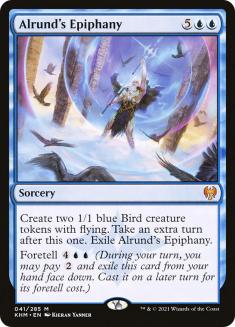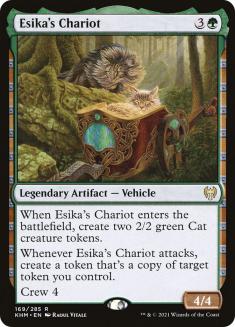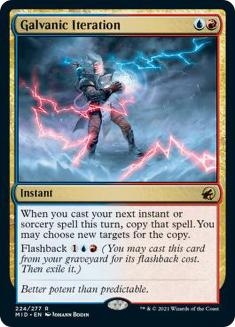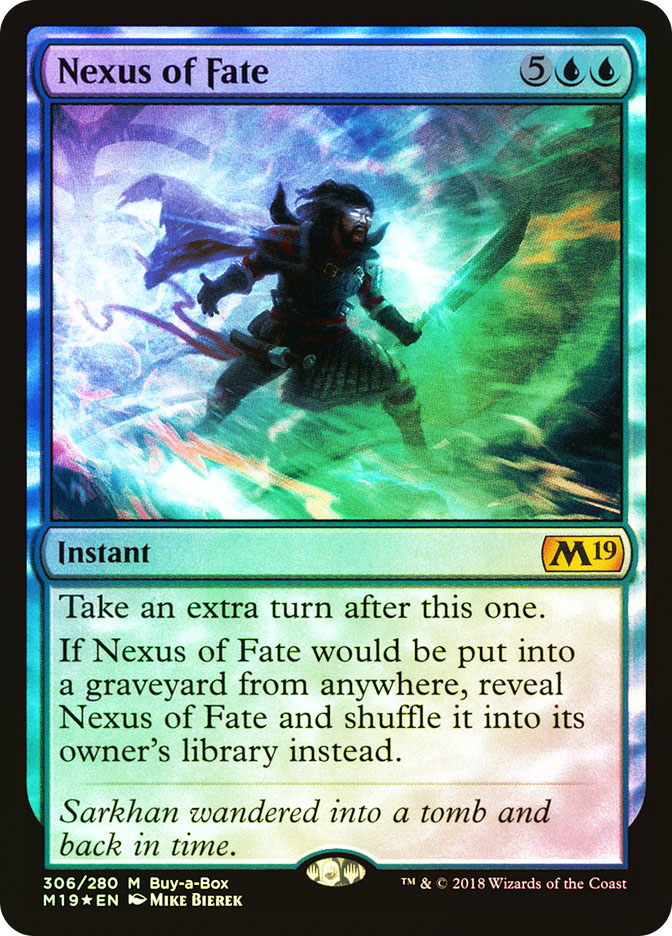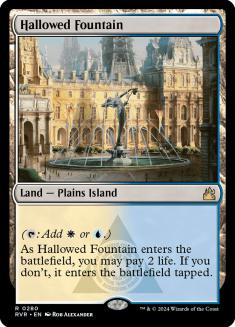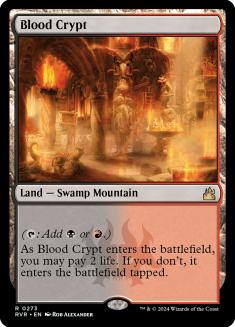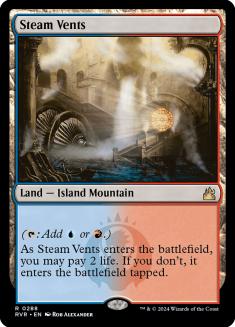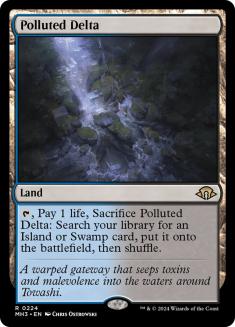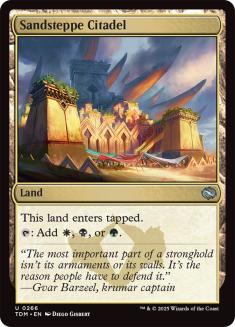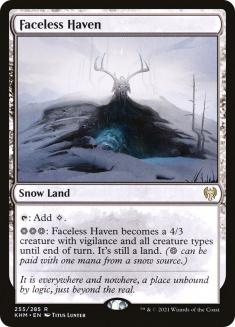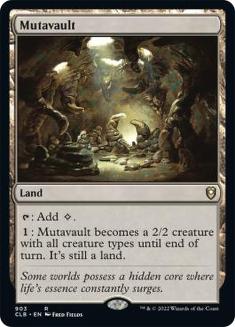Earlier this week, Ross Merriam wrote an article about his thoughts on banning Alrund’s Epiphany from Standard. My article will be a direct rebuttal, so make sure to read his first. You can find it here.
You Got the Wrong Guy
Ross’s first argument is that Alrund’s Epiphany is directly warping the metagame. It completely obliterates midrange strategies, but there have been exactly zero tournaments where Alrund’s Epiphany dominated. Ladder play is often unreliable as far as strength of schedule is concerned, and I saw all sorts of decks performing well over the last week and change. Without a doubt I have enjoyed playing Alrund’s Epiphany, and have been winning with it, but I can regularly point to mistakes in my opponent’s deckbuilding, sideboarding, or play that directly led to me winning matches. Alrund’s Epiphany is good, but not unbeatable.
My first dozen games with Izzet Dragons❄ went well, but I quickly realized some severe weaknesses in my gameplan. As those weaknesses made themselves more pronounced, Brad Nelson and Eric Froehlich were working on and streaming a significantly different Izzet deck based around Galvanic Iteration. I went 7-0 with the initial build on ladder, but my win percentage started to shrink when facing off against Mono-White Aggro❄ and Mono-Green Aggro❄.
Lands (23)
Spells (37)

An adaptive metagame that sees different decks atop the roost every few days is a good thing. If Alrund’s Epiphany was the breakout Standard deck, Mono-Green Aggro❄ was certainly the solution. If people keep playing Izzet Epiphany, they will continue getting slaughtered by Mono-Green. Eventually, we should see a reduction in presence of Izzet Epiphany, which will open up some room for various midrange strategies, like Blood on the Snow, to make their way back into the format. Once those decks topple Mono-Green and Mono-White, Epiphany will come back and the cycle will start anew.
But what if that doesn’t happen?
There’s so little information about the current Standard format that I find it difficult to justify a ban on anything, but there’s certainly no data that suggests Alrund’s Epiphany has a higher win percentage than Blizzard Brawl. If you’re going to ban anything right away based on little to no evidence, my gut would fervently point me toward a different card…
Is Mono-Green Aggro the Best Deck?
Mono-Green Aggro❄ is an archetype that’s certainly acceptable as the format’s best deck. Creatures, planeswalkers, enchantment engines, and mana generation? Sign me up. Ross’s argument here is that Mono-Green Aggro❄ and Mono-White Aggro❄ being dominant factors is a result of Alrund’s Epiphany pushing midrange out of the format. I’m of the opinion that Mono-Green Aggro❄ would still be dominant if Alrund’s Epiphany didn’t exist.
Mono-Green Aggro❄ hits hard and fast. It puts pressure on you from a bunch of different angles, and has one of the most efficient removal spells in the format in Blizzard Brawl. Since both players are incentivized to tap out in a Creature VS Creature matchup, cards like Blizzard Brawl have bloomed in both playability and popularity. This means they’re favored in most creature fights because they have access to the cheapest removal spell. They also have bigger creatures in regards to mana value than any other aggressive strategy. These two factors makes playing Mono-Green Aggro❄ over any other aggressive deck an easy decision.
Creatures (18)
Planeswalkers (2)
Lands (23)
Spells (17)

Are there some midrange decks that beat Mono-Green Aggro❄ regularly? Grzegorz ‘Urlich’ Kowalski has been promoting Mono-Black Control❄ based around Blood on the Snow as the perfect foil. The problem here is that Mono-Black doesn’t really beat much else. If the format is a three deck metagame featuring Izzet Epiphany, Mono-Green, and Mono-Black, each of these swallows up the other. That’s balance. Is it healthy? That’s an entirely different story, but I don’t believe this is the fault of Alrund’s Epiphany, but rather a lack of incentive to play multiple colors, and weak cycles of dual lands that don’t enable two- or three-color aggro decks.
Combo Control’s Dominance
Ross posits that combo-control is one of Magic’s most successful and toxic archetypes. In his opinion, Izzet Epiphany embodies this role by playing a control game in the early turns, but winning with a flourish. Galvanic Iteration plus Alrund’s Epiphany is certainly powerful, and plays like a combo that is relatively difficult to interact with. At eight mana and two cards, with both spells needing to be played in the same turn, is that type of combo really all that bad?
Ross’s argument here is actually pretty good. Alrund’s Epiphany on its own is quite strong because it’s a break even on resources spent. You get the card and mana back on the next turn, effectively making it free with a couple of Birds to boot. I think the only part that starts to break down in his description of the archetype is that Galvanic Iteration is a “good card” outside of pairing it with Alrund’s Epiphany.
It is not.
Is it playable outside of Alrund’s Epiphany? Certainly. However, in order to make it decent, you have to make some serious concessions in deckbuilding. For example, Memory Deluge is one of the best spells in this type of deck, but you can’t use Galvanic Iteration to copy it due to the mana spent clause. Because of this, Brad Nelson began playing some number of Behold the Multiverse, but I still found Galvanic Iteration to be very clunky outside of copying exactly Alrund’s Epiphany.
Creatures (4)
Lands (23)
Spells (33)
- 2 Duress
- 1 Bloodchief's Thirst
- 2 Spikefield Hazard
- 1 Cinderclasm
- 2 Jwari Disruption
- 4 Alrund's Epiphany
- 1 Demon Bolt
- 1 Prismari Command
- 4 Expressive Iteration
- 1 Power Word Kill
- 2 Galvanic Iteration
- 3 The Celestus
- 1 Burn Down the House
- 3 Memory Deluge
- 1 Cathartic Pyre
- 4 Fading Hope
Sideboard

Combo-control is also not an “unbeatable” archetype. Ross talks about “the squeeze,” wherein the combo-control pilot can play a control role if you’re interacting, or a combo role if you’re ignoring. That means the type of interaction you throw at them is never going to be the “right kind of interaction” because they can bend around it and lean on their gameplan that’s stronger in a particular situation. His assessment that linear aggro is the best foil is spot on, and that’s exactly what we’re seeing with the rise of Mono-White Aggro❄. We just disagree on whether or not this is healthy for Standard.
A torrent of interaction is also a fine way to beat decks like this. Jund is traditionally favored against Splinter Twin because it can apply pressure via cheap threats while playing pinpoint discard effects. There doesn’t exist a Tarmogoyf style threat in Standard, and the discard/interaction isn’t nearly as potent, but there are still plenty of ways to dismantle Izzet Epiphany. I should know. I’ve been losing with it a lot over the last few days.
Alrund’s Epiphany VS Nexus of Fate
Effects that grant you an extra turn have become a mainstay of Standard over the last decade. It seems like every other set contains a blue mythic rare that does something minor while giving you an extra turn, or just costs eight mana. Rarely do these cards break the format, but on occasion an engine or pairing will push them over the top. The last one that broke the game was Nexus of Fate.
Nexus of Fate wasn’t copied a bunch. It wasn’t really even all that good unless you paired it with some sort of card or mana engine. I had a lot of issues with Nexus of Fate particularly, but even I could see that Wilderness Reclamation was the real culprit. The burst of mana you generated allowed you to start taking turns quickly, and the card draw and selection from stuff like Search for Azcanta helped you take infinite turns. While the reshuffle clause on Nexus of Fate made this all possible since you couldn’t deck yourself, you didn’t gain any serious advantage from casting Nexus of Fate on its own. You needed those mana and card engines for it to do much of anything. I would regularly see Nexus of Fate cast for the full seven mana with no actual gain on the following turn because it was only as good as the surrounding cast.
Planeswalkers (6)
Lands (26)
Spells (28)

Alrund’s Epiphany is not at all like that, as the two Birds you generate are worth quite a lot. One of the reasons why Nexus of Fate had such a negative reputation is that they stole all the time allotted in a single game or match. Once they started taking extra turns, it would be tens of minutes before the game actually ended. Imagine sitting across the table from someone spending fifteen minutes in a row trying to kill you and not being able to take any game actions. If Nexus of Fate decks killed their opponent faster, I don’t think anything would’ve been banned. It didn’t have a particularly high win percentage, it was just the worst play experience I’ve ever encountered.
Alrund’s Epiphany kills you quickly. A chain of them should almost always do the trick, but that’s probably a good thing. Control decks that drag out games are some of the most despised decks in history. Players don’t like feeling helpless for long, and luckily they don’t have to.
It’s okay for seven and eight-mana spells to be game breaking. It’s okay for them to increase your chances of winning once they resolve. It’s okay to pair them with other spells for greater effect. The downside to playing cards like these is that they have little to no value in the early turns. That tension is what makes games of Magic great, and what makes deckbuilding fun.
The Importance of Midrange
In his initial article, Ross states that midrange decks being the “best deck” in a format usually leads to more satisfying gameplay experiences. In this respect, we can agree. Some of the best formats in Magic’s history have had midrange decks be a focal point. While I may disagree on Thragtusk specifically, my favorite memories of Standard had all manner of midrange decks. I don’t think this was specifically thanks to any one creature, but more likely due to other factors.
1. Ravnica Shocklands
Ravnica shocklands are the perfect dual lands for Standard. They’re versatile enough to go in any deck, and the cost of life lost to play them untapped is perfectly balanced. Aggro decks want them because they can fluidly cast their secondary color spells. Midrange decks don’t mind them because they usually have Siege Rhino or Thragtusk to gain the life back. Control decks use them, but they’re at their worst here because they have a tougher time defending themselves from hyper aggressive strategies. All three times they’ve been in Standard, players have emphatically agreed that they were excellent formats.
2. Fetchlands and Khans of Trokair Tri-lands
This format was a bit more degenerate, but when Standard has fetches and dual lands, you can pair just about any two cards together. It’s no secret that most of these “great” formats are specifically good because the lands allow for more possible combinations. Bad mana leads to homogenization around the format’s most powerful cards.
3. Faceless Haven and Mutavault
Some of the “bad” formats we’ve played have mostly been due to bad mana, but they also usually had a creature-land like Mutavault or Faceless Haven to create incentive for playing one color. While that isn’t necessarily a bad thing, it can lead to stale formats featuring four or fewer total archetypes. We’re starting to see that right now in Innistrad: Midnight Hunt Standard.
Lands are the building block of any format. I’m not advocating for perfect mana for three-, four-, or five-color decks. I like access to these types of builds but with serious drawbacks. Two life per untapped land is a nearly perfect cost, and it’s easy to pair them with checklands like Isolated Chapel for smooth transitions in the later turns.
My Solution
The short answer is “wait.” I don’t think any card has given us a good reason to be banned. Alrund’s Epiphany does check some problematic boxes, but it’s pretty clear that Mono-Green Aggro❄ is the perfect foil. If the metagame adapts like it should, midrange decks should start popping up soon to prey on aggro. If that doesn’t happen, perhaps it’s time to take more serious action…
Ban Alrund’s Epiphany AND Esika’s Chariot.
Esika’s Chariot has big Gideon, Ally of Zendikar vibes. Not only does it create multiple bodies on resolution, but it also provides a snowball effect by generating more threats and attacking for huge chunks of damage. While you can interact with it a number of ways, most of that interaction comes at a disadvantage. It’s almost impossible to kill the Esika’s Chariot and the tokens with a single card. Outside of a counterspell, Prismari Command is the only thing that comes close to checking it on an even playing field.
If Alrund’s Epiphany is the best card in Standard, Esika’s Chariot is far and away the second best. If you ban Alrund’s Epiphany alone, I think you’ll create a format where Esika’s Chariot is the most important and dominant card. I don’t think having a card like Esika’s Chariot being the best card in Standard is necessarily a bad thing, but I’m under the impression that it will be such a dominant force that no other deck will be able to keep up. Half the time when Izzet Epiphany beats an Esika’s Chariot deck, the battlefield is littered with creatures made by Esika’s Chariot. It’s such a hopeless proposition to beat Esika’s Chariot on an even playing field that you can only hope to go over the top of it or fly over it. The landslide advantage and instantaneous payoff is just too much to overcome via traditional means.
Is Alrund’s Epiphany worth banning? Not right now. I want to see the results from Magic World Championship XXVII and wait a few weeks to see if the format can self correct. Alrund’s Epiphany is very powerful and worth keeping an eye on, but I would argue that Esika’s Chariot is in the same boat. If you take one, I think you should take the other.
Final Thoughts
Banning any card has serious consequences. At the end of the day, you have to weigh community support against the time and money invested in accumulating these cards. Every ban has cascading effects that cause people to quit, and entire decks full of rare and mythic wildcards evaporate in playability. If Alrund’s Epiphany is killed off, Galvanic Iteration is effectively dead as well. This is why you’ll see WotC take action against some of the lesser cards in a given archetype in order to neuter but not kill specific decks.
Should Alrund’s Epiphany be banned? I don’t think so. It doesn’t check any of my disaster boxes and currently isn’t winning. It’s certainly suppressing midrange decks in Standard, but Mono-Green Aggro❄ should be a natural predator. If midrange decks don’t come back in a few weeks, or Alrund’s Epiphany finds a build that smashes aggro, we can have this conversation again.
It’s no coincidence that the best cards in a given format are often threats that have few or no answers. Interacting with those cards on the stack via counterspells is often the only way to trade with them on a one-for-one basis. Aggro decks tend to get under counterspells, creating a balance between the three major archetypes: aggro, midrange, and control. Without access to better mana, Standard usually devolves into a three deck metagame featuring the best build of each archetype. It’s when one of these archetypes wins too much that we need to look at potential solutions. That’s not the case right now, at least not for Alrund’s Epiphany.
For now, I say: let them fight.


